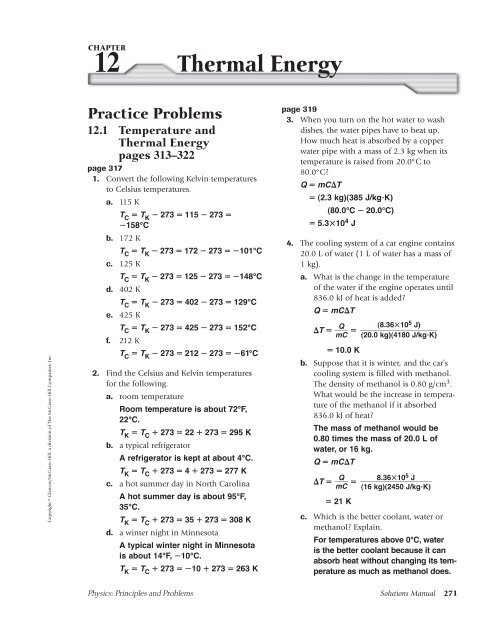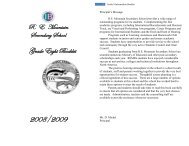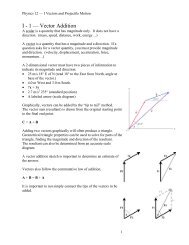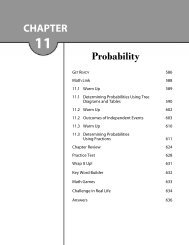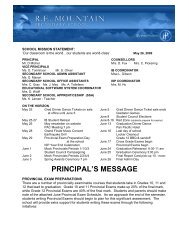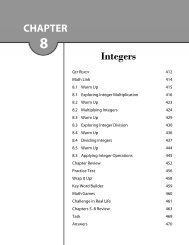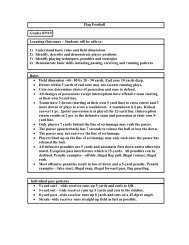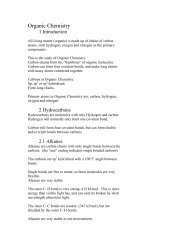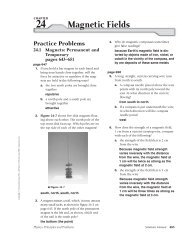Ch 12 Answers
Ch 12 Answers
Ch 12 Answers
Create successful ePaper yourself
Turn your PDF publications into a flip-book with our unique Google optimized e-Paper software.
Copyright © Glencoe/McGraw-Hill, a division of The McGraw-Hill Companies, Inc.<br />
CHAPTER<br />
<strong>12</strong> Thermal Energy<br />
Practice Problems<br />
<strong>12</strong>.1 Temperature and<br />
Thermal Energy<br />
pages 313–322<br />
page 317<br />
1. Convert the following Kelvin temperatures<br />
to Celsius temperatures.<br />
a. 115 K<br />
T C T K 273 115 273 <br />
158°C<br />
b. 172 K<br />
T C T K 273 172 273 101°C<br />
c. <strong>12</strong>5 K<br />
T C T K 273 <strong>12</strong>5 273 148°C<br />
d. 402 K<br />
T C T K 273 402 273 <strong>12</strong>9°C<br />
e. 425 K<br />
T C T K 273 425 273 152°C<br />
f. 2<strong>12</strong> K<br />
T C T K 273 2<strong>12</strong> 273 61°C<br />
2. Find the Celsius and Kelvin temperatures<br />
for the following.<br />
a. room temperature<br />
Room temperature is about 72°F,<br />
22°C.<br />
T K T C 273 22 273 295 K<br />
b. a typical refrigerator<br />
A refrigerator is kept at about 4°C.<br />
T K T C 273 4 273 277 K<br />
c. a hot summer day in North Carolina<br />
A hot summer day is about 95°F,<br />
35°C.<br />
T K T C 273 35 273 308 K<br />
d. a winter night in Minnesota<br />
A typical winter night in Minnesota<br />
is about 14°F, 10°C.<br />
T K T C 273 10 273 263 K<br />
page 319<br />
3. When you turn on the hot water to wash<br />
dishes, the water pipes have to heat up.<br />
How much heat is absorbed by a copper<br />
water pipe with a mass of 2.3 kg when its<br />
temperature is raised from 20.0°C to<br />
80.0°C?<br />
Q mCT<br />
(2.3 kg)(385 J/kgK)<br />
(80.0°C 20.0°C)<br />
5.310 4 J<br />
4. The cooling system of a car engine contains<br />
20.0 L of water (1 L of water has a mass of<br />
1 kg).<br />
a. What is the change in the temperature<br />
of the water if the engine operates until<br />
836.0 kJ of heat is added?<br />
Q mCT<br />
Q (8.3610<br />
T <br />
mC<br />
5 J)<br />
<br />
(20.0 kg)(4180 J/kgK)<br />
10.0 K<br />
b. Suppose that it is winter, and the car’s<br />
cooling system is filled with methanol.<br />
The density of methanol is 0.80 g/cm 3 .<br />
What would be the increase in temperature<br />
of the methanol if it absorbed<br />
836.0 kJ of heat?<br />
The mass of methanol would be<br />
0.80 times the mass of 20.0 L of<br />
water, or 16 kg.<br />
Q mCT<br />
Q 8.3610<br />
T <br />
mC<br />
5 J<br />
<br />
(16 kg)(2450 J/kgK)<br />
21 K<br />
c. Which is the better coolant, water or<br />
methanol? Explain.<br />
For temperatures above 0°C, water<br />
is the better coolant because it can<br />
absorb heat without changing its temperature<br />
as much as methanol does.<br />
Physics: Principles and Problems Solutions Manual 271
<strong>Ch</strong>apter <strong>12</strong> continued<br />
5. Electric power companies sell electricity by the kWh, where 1 kWh 3.610 6 J.<br />
Suppose that it costs $0.08 per kWh to run an electric water heater in your neighborhood.<br />
How much does it cost to heat 75 kg of water from 15°C to 43°C to<br />
fill a bathtub?<br />
Q mCT<br />
(75 kg)(4180 J/kgK)(43°C 15°C)<br />
8.810 6 J<br />
8.810 6 J<br />
<br />
3.610 6 J/kWh<br />
2.4 kWh<br />
(2.4 kWh)($0.15 per kWh) $0.36<br />
page 321<br />
6. A 2.0010 2 -g sample of water at 80.0°C is mixed with 2.0010 2 g of water at<br />
10.0°C. Assume that there is no heat loss to the surroundings. What is the final<br />
temperature of the mixture?<br />
m A C A (T f T Ai ) m B C B (T f T Bi ) 0<br />
Since m A m B and C A C B ,<br />
there is cancellation in this particular case so that<br />
Tf TAi TBi 80.0°C 10.0°C<br />
45.0°C<br />
2<br />
2<br />
7. A 4.0010 2 -g sample of methanol at 16.0°C is mixed with 4.0010 2 g of water<br />
at 85.0°C. Assume that there is no heat loss to the surroundings. What is the<br />
final temperature of the mixture?<br />
m A C A (T f T Ai ) m W C W (T f T Wi ) 0<br />
Since in this particular case, m A m W ,the masses cancel and<br />
T f <br />
C A T Ai C W T Wi<br />
<br />
CA C W<br />
(2450 J/kgK)(16.0°C) (4180 J/kgK)(85.0°C)<br />
59.5°C<br />
2450 J/kgK 4180 J/kgK<br />
8. Three lead fishing weights, each with a mass of 1.0010 2 g and at a temperature<br />
of 100.0°C, are placed in 1.0010 2 g of water at 35.0°C. The final temperature of<br />
the mixture is 45.0°C. What is the specific heat of the lead in the weights?<br />
Heat gained by the water:<br />
Q mCT (0.100 kg)(4180 J/kg°C)(10.0°C) 4.18 kJ<br />
Thus, heat lost by the weights 4.18 kJ m weights C weights T<br />
hence, C weights <br />
(4.184 kJ)(1000 J/kJ)<br />
<br />
(0.100 kg)(55.0°C)<br />
2.5310 2 J/kg°C<br />
272 Solutions Manual Physics: Principles and Problems<br />
Copyright © Glencoe/McGraw-Hill, a division of The McGraw-Hill Companies, Inc.
Copyright © Glencoe/McGraw-Hill, a division of The McGraw-Hill Companies, Inc.<br />
<strong>Ch</strong>apter <strong>12</strong> continued<br />
9. A 1.0010 2 -g aluminum block at 100.0°C<br />
is placed in 1.0010 2 g of water at 10.0°C.<br />
The final temperature of the mixture is<br />
25.0°C. What is the specific heat of the<br />
aluminum?<br />
Heat gained by the water:<br />
Q mCT<br />
(0.100 kg)(4180 J/kg°C)(15.0°C)<br />
6.27 kJ<br />
Thus, heat lost by the aluminum block<br />
6.27 kJ m Aluminum C Aluminum T<br />
Q<br />
hence, CAluminum <br />
mAlum<br />
inumT <br />
<br />
8.3610 2 J/kg°C<br />
Section Review<br />
<strong>12</strong>.1 Temperature and<br />
Thermal Energy<br />
pages 313–322<br />
page 322<br />
10. Temperature Make the following<br />
conversions.<br />
a. 5°C to kelvins<br />
278 K<br />
b. 34 K to degrees Celsius<br />
239°C<br />
c. 2<strong>12</strong>°C to kelvins<br />
485 K<br />
d. 316 K to degrees Celsius<br />
43°C<br />
11. Conversions Convert the following<br />
Celsius temperatures to Kelvin<br />
temperatures.<br />
a. 28°C<br />
301 K<br />
b. 154°C<br />
427 K<br />
c. 568°C<br />
841 K<br />
6.27 kJ<br />
<br />
(0.100 kg)(75.0°C)<br />
d. 55°C<br />
218 K<br />
e. 184°C<br />
Physics: Principles and Problems Solutions Manual 273<br />
89 K<br />
<strong>12</strong>. Thermal Energy Could the thermal energy<br />
of a bowl of hot water equal that of a bowl<br />
of cold water? Explain your answer.<br />
Thermal energy is the measure of the<br />
total energy of all the molecules in an<br />
object. The temperature (hot or cold)<br />
measures the amount of energy per<br />
molecule. If the bowls are identical and<br />
contain the same amount of water, they<br />
have the same number of molecules,<br />
but the bowl of hot water has more<br />
total thermal energy. However, if the<br />
cold water mass is slightly more than<br />
that of the hot water, the two energies<br />
could be equal.<br />
13. Heat Flow On a dinner plate, a baked<br />
potato always stays hot longer than any<br />
other food. Why?<br />
A potato has a large specific heat and<br />
conducts heat poorly, so it loses its<br />
heat energy slowly.<br />
14. Heat The hard tile floor of a bathroom<br />
always feels cold to bare feet even though<br />
the rest of the room is warm. Is the floor<br />
colder than the rest of the room?<br />
The floor is usually at the same temperature<br />
as the rest of the room, but the tile<br />
conducts heat more efficiently than most<br />
materials, so it conducts heat from a<br />
person’s feet, making them feel cold.<br />
15. Specific Heat If you take a plastic spoon<br />
out of a cup of hot cocoa and put it in your<br />
mouth, you are not likely to burn your<br />
tongue. However, you could very easily<br />
burn your tongue if you put the hot cocoa<br />
in your mouth. Why?<br />
The plastic spoon has a lower specific<br />
heat than the cocoa, so it does not<br />
transmit much heat to your tongue as<br />
it cools.
<strong>Ch</strong>apter <strong>12</strong> continued<br />
16. Heat <strong>Ch</strong>efs often use cooking pans made of thick aluminum. Why is thick aluminum<br />
better than thin aluminum for cooking?<br />
Thick aluminum conducts heat better and does not have any “hot spots.”<br />
17. Heat and Food It takes much longer to bake a whole potato than to cook french<br />
fries. Why?<br />
Potatoes do not conduct heat well. Increasing surface area by cutting a<br />
potato into small parts increases heat flow into the potato. Heat flow from<br />
hot oil to the potato is also more efficient than from hot air.<br />
18. Critical Thinking As water heats in a pot on a stove, the water might produce<br />
some mist above its surface right before the water begins to roll. What is happening,<br />
and where is the coolest part of the water in the pot?<br />
The heat flows from the burner (the hottest part) to the top surface of the<br />
water (coldest). The water first transfers heat from bottom to top through<br />
conduction, and then convection begins to move hot water in currents to<br />
the top.<br />
Practice Problems<br />
<strong>12</strong>.2 <strong>Ch</strong>anges of State and the Laws of<br />
Thermodynamics<br />
pages 323–331<br />
page 325<br />
19. How much heat is absorbed by 1.0010 2 g of ice at 20.0°C to become water at<br />
0.0°C?<br />
Q mCT mH f<br />
(0.100 kg)(2060 J/kg°C)(20.0°C) (0.100 kg)(3.3410 5 J/kg)<br />
3.7510 4 J<br />
20. A 2.0010 2 -g sample of water at 60.0°C is heated to steam at 140.0°C. How<br />
much heat is absorbed?<br />
Q mC water T mH v mC steam T<br />
(0.200 kg)(4180 J/kg°C)(100.0°C 60.0°C) (0.200 kg)(2.2610 6 J/kg) <br />
502 kJ<br />
(0.200 kg)(2020 J/kg°C)(140.0°C 100.0°C)<br />
21. How much heat is needed to change 3.0010 2 g of ice at 30.0°C to steam at<br />
130.0°C?<br />
Q mC ice T mH f mC water T mH v mC steam T<br />
(0.300 kg)(2060 J/kg°C)(0.0°C (30.0°C)) (0.300 kg)<br />
(3.3410 5 J/kg) (0.300 kg)(4180 J/kg°C)(100.0°C 0.0°C) <br />
(0.300 kg)(2.2610 6 J/kg) (0.300 kg)(2020 J/kg°C)(130.0°C 100.0°C)<br />
9.4010 2 kJ<br />
274 Solutions Manual Physics: Principles and Problems<br />
Copyright © Glencoe/McGraw-Hill, a division of The McGraw-Hill Companies, Inc.
Copyright © Glencoe/McGraw-Hill, a division of The McGraw-Hill Companies, Inc.<br />
<strong>Ch</strong>apter <strong>12</strong> continued<br />
page 328<br />
22. A gas balloon absorbs 75 J of heat. The balloon<br />
expands but stays at the same temperature.<br />
How much work did the balloon do<br />
in expanding?<br />
U Q W<br />
Since the balloon did not change<br />
temperature, U 0.<br />
Therefore, Q W.<br />
Thus, the balloon did 75 J of work in<br />
expanding.<br />
23. A drill bores a small hole in a 0.40-kg block<br />
of aluminum and heats the aluminum by<br />
5.0°C. How much work did the drill do in<br />
boring the hole?<br />
U Q W block ;sinceW drill W block<br />
and assume no heat added to drill:<br />
0 W drill mCT<br />
(0.40 kg)(897 J/kg°C)(5.0°C)<br />
1.810 3 J<br />
24. How many times would you have to drop a<br />
0.50-kg bag of lead shot from a height of<br />
1.5 m to heat the shot by 1.0°C?<br />
U mCT<br />
(0.50 kg)(130 J/kg°C)(1.0°C)<br />
65 J<br />
Each time the bag is raised its potential<br />
energy is<br />
PE mgh<br />
(0.50 kg)(9.80 m/s 2 )(1.5 m)<br />
7.4 J<br />
When the bag hits the ground this<br />
energy is (mostly) transmitted as work<br />
on the lead shot. The number of drops<br />
65<br />
J<br />
is 9 drops<br />
7.<br />
4 J<br />
25. When you stir a cup of tea, you do about<br />
0.050 J of work each time you circle the<br />
spoon in the cup. How many times would<br />
you have to stir the spoon to heat a 0.15-kg<br />
cup of tea by 2.0°C?<br />
U mCT<br />
(0.15 kg)(4180 J/kg°C)(2.0°C)<br />
1.310 3 J.<br />
The number of stirs is<br />
1. 310<br />
0.<br />
050<br />
3 J<br />
2.610<br />
J<br />
4 stirs<br />
26. How can the first law of thermodynamics<br />
be used to explain how to reduce the<br />
temperature of an object?<br />
Since U Q W, it is possible to<br />
have a negative U and therefore, cool<br />
an object if Q 0 and the object does<br />
work, for instance, by expanding.<br />
Alternatively, have W 0 and Q<br />
negative by having it transfer heat to<br />
its surroundings. Any combination of<br />
these will work well.<br />
Section Review<br />
<strong>12</strong>.2 <strong>Ch</strong>anges of State and the<br />
Laws of Thermodynamics<br />
pages 323–331<br />
page 331<br />
27. Heat of Vaporization Old-fashioned heating<br />
systems sent steam into radiators in each<br />
room of a house. In the radiators, the steam<br />
condensed back to water. Analyze this<br />
process and explain how it heated a room.<br />
The condensing steam released its heat<br />
of vaporization into the room and was<br />
then circulated back to the boiler to<br />
receive the heat of vaporization again.<br />
28. Heat of Vaporization How much heat is<br />
needed to change 50.0 g of water at 80.0°C<br />
to steam at 110.0°C?<br />
Q mC water T mH v mC steam T<br />
(0.500 kg)(4180 J/kg°C)(100.0°C <br />
80.0°C) (0.500 kg)<br />
(2.2610 6 J/kg) (0.500 kg)<br />
(2020 J/kg°C)(110.0°C 100.0°C)<br />
1.1810 5 J<br />
Physics: Principles and Problems Solutions Manual 275
<strong>Ch</strong>apter <strong>12</strong> continued<br />
29. Heat of Vaporization The specific heat<br />
of mercury is 140 J/kg°C. Its heat of vaporization<br />
is 3.0610 5 J/kg. How much energy<br />
is needed to heat 1.0 kg of mercury metal<br />
from 10.0°C to its boiling point and<br />
vaporize it completely? The boiling point<br />
of mercury is 357°C.<br />
Q mC Hg T mH v<br />
(1.0 kg)(140 J/kg°C)<br />
(357°C 10.0°C) <br />
(1.0 kg)(3.0610 5 J/kg)<br />
3.510 5 J<br />
30. Mechanical Energy and Thermal Energy<br />
James Joule carefully measured the difference<br />
in temperature of water at the top and<br />
bottom of a waterfall. Why did he expect a<br />
difference?<br />
The water at the top has gravitational<br />
potential energy that is dissipated into<br />
thermal energy when the water splashes<br />
at the bottom. The water should be<br />
hotter at the bottom, but not by much.<br />
31. Mechanical Energy and Thermal Energy<br />
A man uses a 320-kg hammer moving at<br />
5.0 m/s to smash a 3.0-kg block of lead<br />
against a 450-kg rock. When he measured<br />
the temperature he found that it had<br />
increased by 5.0°C. Explain how this<br />
happened.<br />
Part of the kinetic energy of the hammer<br />
is absorbed as thermal energy by the<br />
lead block. The hammer’s energy is<br />
1<br />
2 mv2 1<br />
2 (320 kg)(5.0 m/s)2 4.0 kJ.<br />
The change in thermal energy of the<br />
block is<br />
U mCT<br />
(3.0 kg)(130 J/kgK)(5.0°C)<br />
2.0 kJ<br />
Hence, about half of the hammer’s<br />
energy went to the lead block.<br />
32. Mechanical Energy and Thermal Energy<br />
Water flows over a fall that is <strong>12</strong>5.0 m high,<br />
as shown in Figure <strong>12</strong>-17. If the potential<br />
energy of the water is all converted to thermal<br />
energy, calculate the temperature difference<br />
between the water at the top and the<br />
bottom of the fall.<br />
■ Figure <strong>12</strong>-17<br />
PE gravity Q absorbed by water<br />
mgh mCT<br />
T gh<br />
<br />
C<br />
<br />
<strong>12</strong>5.0 m<br />
(9.80 m/s 2 )(<strong>12</strong>5.0 m)<br />
<br />
4180 J/kg°C<br />
0.293°C rise in temperature at the<br />
bottom<br />
33. Entropy Evaluate why heating a home<br />
with natural gas results in an increased<br />
amount of disorder.<br />
The gas releases heat, Q,at its combustion<br />
temperature, T.The natural gas<br />
molecules break up and combust with<br />
oxygen. The heat is distributed in many<br />
new ways, and the natural gas molecules<br />
cannot readily be reassembled.<br />
34. Critical Thinking A new deck of cards has<br />
all the suits (clubs, diamonds, hearts, and<br />
spades) in order, and the cards are ordered<br />
by number within the suits. If you shuffle<br />
the cards many times, are you likely to<br />
return the cards to their original order?<br />
Explain. Of what physical law is this an<br />
example?<br />
The cards are very unlikely to return to<br />
their original order. This is an example<br />
of the second law of thermodynamics,<br />
in which disorder increases.<br />
276 Solutions Manual Physics: Principles and Problems<br />
Copyright © Glencoe/McGraw-Hill, a division of The McGraw-Hill Companies, Inc.
Copyright © Glencoe/McGraw-Hill, a division of The McGraw-Hill Companies, Inc.<br />
<strong>Ch</strong>apter <strong>12</strong> continued<br />
<strong>Ch</strong>apter Assessment<br />
Concept Mapping<br />
page 336<br />
35. Complete the following concept map using<br />
the following terms: heat, work, internal energy.<br />
First law of<br />
thermodynamics<br />
heat<br />
internal<br />
energy<br />
work<br />
entropy<br />
temperature<br />
external<br />
forces<br />
Mastering Concepts<br />
page 336<br />
36. Explain the differences among the mechanical<br />
energy of a ball, its thermal energy, and<br />
its temperature. (<strong>12</strong>.1)<br />
The mechanical energy is the sum of<br />
the potential and kinetic energies of the<br />
ball considered as one mass. The thermal<br />
energy is the sum of the potential<br />
and kinetic energies of the individual<br />
particles that make up the mass of the<br />
ball. The temperature is a measure of<br />
the internal energy of the ball.<br />
37. Can temperature be assigned to a vacuum?<br />
Explain. (<strong>12</strong>.1)<br />
No, because there are no particles that<br />
have energy in a vacuum.<br />
38. Do all of the molecules or atoms in a liquid<br />
have the same speed? (<strong>12</strong>.1)<br />
No. There is a distribution of velocities<br />
of the atoms or molecules.<br />
39. Is your body a good judge of temperature?<br />
On a cold winter day, a metal doorknob feels<br />
much colder to your hand than a wooden<br />
door does. Explain why this is true. (<strong>12</strong>.1)<br />
Your skin measures heat flow to or from<br />
itself. The metal doorknob absorbs heat<br />
from your skin faster than the wooden<br />
door, so it feels colder.<br />
40. When heat flows from a warmer object in<br />
contact with a colder object, do the two<br />
have the same temperature changes? (<strong>12</strong>.1)<br />
The two objects will change temperatures<br />
depending on their masses and<br />
specific heats. The temperature changes<br />
are not necessarily the same for each.<br />
41. Can you add thermal energy to an object<br />
without increasing its temperature? Explain.<br />
(<strong>12</strong>.2)<br />
When you melt a solid or boil a<br />
liquid, you add thermal energy<br />
without changing the temperature.<br />
42. When wax freezes, does it absorb or release<br />
energy? (<strong>12</strong>.2)<br />
When wax freezes, it releases energy.<br />
43. Explain why water in a canteen that is surrounded<br />
by dry air stays cooler if it has a<br />
canvas cover that is kept wet. (<strong>12</strong>.2)<br />
When the water in the cover evaporates<br />
into the dry air, it must absorb an<br />
amount of energy proportional to its<br />
heat of fusion. In doing so, it cools off<br />
the canteen. This works only if the air<br />
is dry; if the air is humid, then the water<br />
will not evaporate.<br />
44. Which process occurs at the coils of a running<br />
air conditioner inside a house, vaporization<br />
or condensation? Explain. (<strong>12</strong>.2)<br />
Inside the house, the coolant is evaporating<br />
in the coils to absorb energy<br />
from the rooms.<br />
Applying Concepts<br />
page 336<br />
45. Cooking Sally is cooking pasta in a pot of<br />
boiling water. Will the pasta cook faster if<br />
the water is boiling vigorously or if it is<br />
boiling gently?<br />
It should make no difference. Either way,<br />
the water is at the same temperature.<br />
Physics: Principles and Problems Solutions Manual 277
<strong>Ch</strong>apter <strong>12</strong> continued<br />
46. Which liquid would an ice cube cool faster,<br />
water or methanol? Explain.<br />
Methanol, because it has a lower<br />
specific heat; for a given mass and heat<br />
transfer, it generates a bigger T since<br />
Q mCT.<br />
47. Equal masses of aluminum and lead are<br />
heated to the same temperature. The pieces<br />
of metal are placed on a block of ice. Which<br />
metal melts more ice? Explain.<br />
The specific heat of aluminum is much<br />
greater than that of lead; therefore, it<br />
melts more ice.<br />
48. Why do easily vaporized liquids, such as<br />
acetone and methanol, feel cool to the skin?<br />
As they evaporate, they absorb their<br />
heat of vaporization from the skin.<br />
49. Explain why fruit growers spray their trees<br />
with water when frost is expected to protect<br />
the fruit from freezing.<br />
The water on the leaves will not freeze<br />
until it can release its heat of fusion.<br />
This process keeps the leaves warmer<br />
longer. The heat capacity of the ice<br />
slows down the cooling below 0°C.<br />
50. Two blocks of lead have the same temperature.<br />
Block A has twice the mass of block B.<br />
They are dropped into identical cups of<br />
water of equal temperatures. Will the two<br />
cups of water have equal temperatures after<br />
equilibrium is achieved? Explain.<br />
The cup with block A will be hotter<br />
because block A contains more thermal<br />
energy.<br />
51. Windows Often, architects design most of<br />
the windows of a house on the north side.<br />
How does putting windows on the south side<br />
affect the heating and cooling of the house?<br />
In the northern hemisphere, the sunlight<br />
comes from the south. The Sun’s<br />
light would help heat the house in the<br />
winter but also would also heat the<br />
house in the summer.<br />
Mastering Problems<br />
<strong>12</strong>.1 Temperature and Thermal Energy<br />
pages 336–337<br />
Level 1<br />
52. How much heat is needed to raise the<br />
temperature of 50.0 g of water from<br />
4.5°C to 83.0°C?<br />
Q mCT<br />
(0.0500 kg)(4180 J/kg°C)<br />
(83.0°C 4.5°C)<br />
1.6410 4 J<br />
53. A 5.0010 2 -g block of metal absorbs 5016 J<br />
of heat when its temperature changes from<br />
20.0°C to 30.0°C. Calculate the specific<br />
heat of the metal.<br />
Q mCT<br />
Q<br />
so C <br />
mT<br />
<br />
<br />
1.0010 3 J/kg°C<br />
1.0010 3 J/kgK<br />
54. Coffee Cup A 4.0010 2 -g glass coffee cup<br />
is 20.0°C at room temperature. It is then<br />
plunged into hot dishwater at a temperature<br />
of 80.0°C, as shown in Figure <strong>12</strong>-18.<br />
If the temperature of the cup reaches that of<br />
the dishwater, how much heat does the cup<br />
absorb? Assume that the mass of the dishwater<br />
is large enough so that its temperature<br />
does not change appreciably.<br />
4.0010 2 g<br />
Q mCT<br />
5016 J<br />
<br />
(5.0010 1 kg)(30.0°C 20.0°C)<br />
20.0°C 80.0°C<br />
(4.0010 1 kg)(840 J/kg°C)<br />
(80.0°C 20.0°C)<br />
2.0210 4 J<br />
■ Figure <strong>12</strong>-18<br />
278 Solutions Manual Physics: Principles and Problems<br />
Copyright © Glencoe/McGraw-Hill, a division of The McGraw-Hill Companies, Inc.
Copyright © Glencoe/McGraw-Hill, a division of The McGraw-Hill Companies, Inc.<br />
<strong>Ch</strong>apter <strong>12</strong> continued<br />
55. A 1.0010 2 -g mass of tungsten at 100.0°C is placed in 2.0010 2 g of water<br />
at 20.0°C. The mixture reaches equilibrium at 21.6°C. Calculate the specific heat<br />
of tungsten.<br />
Q T Q W 0<br />
or m T C T T T m W C W T W<br />
CT mWCWTW<br />
(0.200 kg)(4180 J/kgK)(21.6°C 20.0°C)<br />
<br />
mTTT<br />
(0.100 kg)(21.6°C 100.0°C)<br />
171 J/kgK<br />
56. A 6.010 2 -g sample of water at 90.0°C is mixed with 4.0010 2 g of water at<br />
22.0°C. Assume that there is no heat loss to the surroundings. What is the final<br />
temperature of the mixture?<br />
T f <br />
but C A C B because both liquids are water, and the C’s will divide out.<br />
63°C<br />
57. A 10.0-kg piece of zinc at 71.0°C is<br />
placed in a container of water, as<br />
shown in Figure <strong>12</strong>-19. The water<br />
has a mass of 20.0 kg and a<br />
temperature of 10.0°C before the<br />
zinc is added. What is the final<br />
temperature of the water and<br />
the zinc?<br />
T f <br />
<br />
m A C A T Ai m B C B T Bi<br />
<br />
m A C A m B C B<br />
(6.010<br />
Tf <br />
2 g)(90.0°C) (4.00102 g)(22.0°C)<br />
<br />
6.0102 g 4.00102 mATAi mBTBi <br />
mA mB g<br />
m A C A T Ai m B C B T Bi<br />
<br />
m A C A m B C B<br />
(10.0 kg)(388 J/kgK)(71.0°C) (20.0 kg)(4180 J/kgK)(10.0°C)<br />
<br />
(10.0 kg)(388 J/kgK) (20.0 kg)(4180 J/kgK)<br />
<strong>12</strong>.7°C<br />
Level 2<br />
58. The kinetic energy of a compact car moving at 100 km/h is 2.910 5 J. To get a<br />
feeling for the amount of energy needed to heat water, what volume of water<br />
(in liters) would 2.910 5 J of energy warm from room temperature (20.0°C) to<br />
boiling (100.0°C)?<br />
Q mCT VCT where is the density of the material<br />
Q<br />
2.910<br />
so, V <br />
CT<br />
5 J<br />
<br />
(1.00 kg/L)(4180 J/kg°C)(100.0°C 20.0°C)<br />
0.87 L<br />
20.0 kg<br />
10.0°C<br />
Physics: Principles and Problems Solutions Manual 279<br />
10.0 kg<br />
■ Figure <strong>12</strong>-19
<strong>Ch</strong>apter <strong>12</strong> continued<br />
59. Water Heater A 3.010 2 -W electric<br />
immersion heater is used to heat a cup<br />
of water, as shown in Figure <strong>12</strong>-20. The<br />
cup is made of glass, and its mass is<br />
3.0010 2 g. It contains 250 g of water at<br />
15°C. How much time is needed to bring<br />
the water to the boiling point? Assume<br />
that the temperature of the cup is the<br />
same as the temperature of the water at<br />
all times and that no heat is lost to the air.<br />
Q m G C G T G m W C W T W<br />
but T G T W ,so<br />
Q (m G C G m W C W )T<br />
((0.300 kg)(840 J/kg°C) (0.250 kg)(4180 J/kg°C))(100.0°C 15°C)<br />
1.110 5 J<br />
Now P E<br />
Q<br />
t t ,so<br />
t Q<br />
P 1.<br />
1105<br />
J<br />
<br />
3. 00102<br />
J/s<br />
370 s 6.1 min<br />
60. Car Engine A 2.5010 2 -kg cast-iron car engine contains water as a coolant.<br />
Suppose that the engine’s temperature is 35.0°C when it is shut off, and the air<br />
temperature is 10.0°C. The heat given off by the engine and water in it as they cool<br />
to air temperature is 4.4010 6 J. What mass of water is used to cool the engine?<br />
Q m W C W T m i C i T<br />
Q mi<br />
mW <br />
CW Ci<br />
T<br />
T (4.410<br />
<br />
6 J) ((2.50102 kg)(450 J/kg°C)(35.0°C 10.0°C))<br />
<br />
(4180 J/kg°C)(35.0°C 10.0°C)<br />
15 kg<br />
<strong>12</strong>.2 <strong>Ch</strong>anges of State and the Laws of Thermodynamics<br />
page 337<br />
Level 1<br />
61. Years ago, a block of ice with a mass of about 20.0 kg was used daily in a home<br />
icebox. The temperature of the ice was 0.0°C when it was delivered. As it melted,<br />
how much heat did the block of ice absorb?<br />
Q mH f (20.0 kg)(3.3410 5 J/kg) 6.6810 6 J<br />
62. A 40.0-g sample of chloroform is condensed from a vapor at 61.6°C to a liquid at<br />
61.6°C. It liberates 9870 J of heat. What is the heat of vaporization of chloroform?<br />
Q mHv Hv 2.47105 Q 9870 J<br />
<br />
J/kg<br />
m 0.0400 kg<br />
280 Solutions Manual Physics: Principles and Problems<br />
250 g<br />
15°C<br />
3.0010 2 g<br />
3.0010 2 W<br />
■ Figure <strong>12</strong>-20<br />
Copyright © Glencoe/McGraw-Hill, a division of The McGraw-Hill Companies, Inc.
Copyright © Glencoe/McGraw-Hill, a division of The McGraw-Hill Companies, Inc.<br />
<strong>Ch</strong>apter <strong>12</strong> continued<br />
63. A 750-kg car moving at 23 m/s brakes to a<br />
stop. The brakes contain about 15 kg of iron,<br />
which absorbs the energy. What is the<br />
increase in temperature of the brakes?<br />
During braking, the kinetic energy of<br />
the car is converted into heat<br />
energy. So,<br />
KE C Q B 0.0, and KE C <br />
m B C B T 0.0 so,<br />
T KE<br />
<br />
C<br />
<br />
mBCB<br />
1<br />
2 mC (vf 2 v 2<br />
i )<br />
mBCB <br />
29°C<br />
Level 2<br />
64. How much heat is added to 10.0 g of ice at<br />
20.0°C to convert it to steam at <strong>12</strong>0.0°C?<br />
Amount of heat needed to heat ice to<br />
0.0°C:<br />
Q mCT<br />
(0.0100 kg)(2060 J/kg°C)<br />
4<strong>12</strong> J<br />
(0.0°C (20.0°C))<br />
Amount of heat to melt ice:<br />
Q mH f<br />
(0.0100 kg)(3.3410 5 J/kg)<br />
3.3410 3 J<br />
Amount of heat to heat water to<br />
100.0°C:<br />
Q mCT<br />
(0.0100 kg)(4180 J/kg°C)<br />
(100.0°C 0.0°C)<br />
4.1810 3 J<br />
Amount of heat to boil water:<br />
Q mH v<br />
1<br />
2 (750 kg)(0.02 (23 m/s) 2 )<br />
<br />
(15 kg)(450 J/kg°C)<br />
(0.0100 kg)(2.2610 6 J/kg)<br />
2.2610 4 J<br />
Amount of heat to heat steam to<br />
<strong>12</strong>0.0°C:<br />
Q mCT<br />
(0.0100 kg)(2060 J/kg°C)<br />
404 J<br />
(<strong>12</strong>0.0°C 100.0°C)<br />
The total heat is<br />
4<strong>12</strong> J 3.3410 3 J 4.1810 3 J <br />
2.2610 4 J 404 J 3.0910 4 J<br />
65. A 4.2-g lead bullet moving at 275 m/s<br />
strikes a steel plate and comes to a stop. If<br />
all its kinetic energy is converted to thermal<br />
energy and none leaves the bullet, what is<br />
its temperature change?<br />
Because the kinetic energy is converted<br />
to thermal energy, KE Q 0. So<br />
KE m B C B T and<br />
KE<br />
T <br />
m C<br />
B<br />
B<br />
and the mass of the bullet divides out so<br />
T <br />
<br />
1<br />
2 (v f 2 v i 2 )<br />
CB<br />
1<br />
2 ((0.0 m/s)2 (275 m/s) 2 )<br />
<br />
130 J/kg°C<br />
290°C<br />
1<br />
2 m B (v f 2 v i 2 )<br />
mB C B<br />
66. Soft Drink A soft drink from Australia is<br />
labeled “Low-Joule Cola.” The label says<br />
“100 mL yields 1.7 kJ.” The can contains<br />
375 mL of cola. <strong>Ch</strong>andra drinks the cola<br />
and then wants to offset this input of food<br />
energy by climbing stairs. How high would<br />
<strong>Ch</strong>andra have to climb if she has a mass of<br />
65.0 kg?<br />
<strong>Ch</strong>andra gained (3.75)(1.7 kJ) 6.410 3 J<br />
of energy from the drink.<br />
To conserve energy, E PE 0 or<br />
6.410 3 J mgh so,<br />
h 6.4103<br />
J 6.410<br />
<br />
mg<br />
3 J<br />
<br />
(65.0 kg)(9.80 m/s2 )<br />
1.010 1 m, or about three flights<br />
of stairs<br />
Physics: Principles and Problems Solutions Manual 281
<strong>Ch</strong>apter <strong>12</strong> continued<br />
Mixed Review<br />
pages 337–338<br />
Level 1<br />
67. What is the efficiency of an engine that produces<br />
2200 J/s while burning enough gasoline<br />
to produce 5300 J/s? How much waste<br />
heat does the engine produce per second?<br />
Efficiency 100 2<br />
W<br />
200<br />
J<br />
100<br />
QH<br />
5300<br />
J<br />
42%<br />
The heat loss is<br />
5300 J 2200 J 2900 J<br />
68. Stamping Press A metal stamping machine<br />
in a factory does 2100 J of work each time it<br />
stamps out a piece of metal. Each stamped<br />
piece is then dipped in a 32.0-kg vat of water<br />
for cooling. By how many degrees does the<br />
vat heat up each time a piece of stamped<br />
metal is dipped into it?<br />
If we assume the 2100 J of work from<br />
the machine is absorbed as thermal<br />
energy in the stamped piece, then the<br />
vat must absorb 2100 J in the form of<br />
heat from each piece. No work is done<br />
on the water, only heat is transferred.<br />
The change in temperature of the water<br />
is given by<br />
U mCT,<br />
U<br />
therefore T mC<br />
<br />
2100 J<br />
<br />
(32.0 kg)(4180 J/kg°C)<br />
0.016°C.<br />
69. A 1500-kg automobile comes to a stop<br />
from 25 m/s. All of the energy of the<br />
automobile is deposited in the brakes.<br />
Assuming that the brakes are about 45 kg<br />
of aluminum, what would be the change<br />
in temperature of the brakes?<br />
The energy change in the car is<br />
KE 1<br />
2 (1500 kg)(25 m/s)2 4.710 5 J.<br />
If all of this energy is transferred<br />
as work to the brakes, then<br />
U KE mCT.<br />
Therefore, T KE<br />
<br />
mC<br />
<br />
<strong>12</strong>°C<br />
70. Iced Tea To make iced tea, you start by<br />
brewing the tea with hot water. Then you<br />
add ice. If you start with 1.0 L of 90°C tea,<br />
what is the minimum amount of ice needed<br />
to cool it to 0°C? Would it be better to let<br />
the tea cool to room temperature before<br />
adding the ice?<br />
Heat lost by the tea<br />
Q mCT<br />
(1.0 kg)(4180 J/kgK)(90°C)<br />
376 kJ<br />
Amount of ice melted<br />
m <br />
Q<br />
Hf<br />
376 kJ<br />
1.1 kg<br />
334 kJ<br />
Thus, you need slightly more ice than<br />
tea, but this ratio would make watery<br />
tea. Let the tea cool to room temperature<br />
before adding the ice.<br />
Level 2<br />
71. A block of copper at 100.0°C comes in contact<br />
with a block of aluminum at 20.0°C, as<br />
shown in Figure <strong>12</strong>-21. The final temperature<br />
of the blocks is 60.0°C. What are the<br />
relative masses of the blocks?<br />
100.0°C<br />
Copper Aluminum<br />
60.0°C<br />
4.710 5 J<br />
<br />
(45 kg)(897 J/kg°C)<br />
20.0°C<br />
60.0°C<br />
Copper Aluminum<br />
■ Figure <strong>12</strong>-21<br />
282 Solutions Manual Physics: Principles and Problems<br />
Copyright © Glencoe/McGraw-Hill, a division of The McGraw-Hill Companies, Inc.
Copyright © Glencoe/McGraw-Hill, a division of The McGraw-Hill Companies, Inc.<br />
<strong>Ch</strong>apter <strong>12</strong> continued<br />
The heat lost from the copper equals<br />
the heat gained by the aluminum. The<br />
T for the copper is 40.0°C and the<br />
aluminum heats by 40.0°C.<br />
therefore,<br />
m copper C copper m aluminum C aluminum<br />
mcopper and <br />
maluminum<br />
897 J/kgK<br />
2.3<br />
385 J/kgK<br />
The copper block has 2.3 times as<br />
much mass as the aluminum block.<br />
72. A 0.35-kg block of copper sliding on the<br />
floor hits an identical block moving at the<br />
same speed from the opposite direction.<br />
The two blocks come to a stop together<br />
after the collision. Their temperatures<br />
increase by 0.20°C as a result of the collision.<br />
What was their velocity before the<br />
collision?<br />
The change in internal energy of the<br />
blocks is<br />
U mCT<br />
(0.70 kg)(385 J/kg°C)(0.20°C)<br />
54 J<br />
Therefore, 54 J equals the kinetic<br />
energy of the blocks before the<br />
collision. 54 J (2)1 mv2 2<br />
v 54<br />
J<br />
g 0. 35<br />
k<br />
<strong>12</strong> m/s<br />
<br />
C aluminum<br />
<br />
Ccopper<br />
Level 3<br />
73. A 2.2-kg block of ice slides across a rough<br />
floor. Its initial velocity is 2.5 m/s and its<br />
final velocity is 0.50 m/s. How much of the<br />
ice block melted as a result of the work<br />
done by friction?<br />
The work done by friction equals the<br />
negative of the change in kinetic energy<br />
of the block, assuming not too much of<br />
the block melted.<br />
KE 1<br />
2 (2.2 kg)(0.50 m/s)2 <br />
1<br />
2 (2.2 kg)(2.5 m/s)2 6.6 J<br />
Therefore, 6.6 J is added to the ice.<br />
The amount of ice melted is given by<br />
Physics: Principles and Problems Solutions Manual 283<br />
m <br />
KE<br />
Hf<br />
6. 6<br />
<br />
3.34105<br />
J<br />
<br />
J/kg<br />
2.010 5 kg<br />
Thinking Critically<br />
page 338<br />
74. Analyze and Conclude A certain heat<br />
engine removes 50.0 J of thermal energy<br />
from a hot reservoir at temperature<br />
T H 545 K and expels 40.0 J of heat to a<br />
colder reservoir at temperature T L 325 K.<br />
In the process, it also transfers entropy from<br />
one reservoir to the other.<br />
a. How does the operation of the engine<br />
change the total entropy of the reservoirs?<br />
As the engine operates, it removes<br />
energy from the hot reservoir.<br />
Therefore, SH QH<br />
so that the<br />
T H<br />
entropy of the hot reservoir<br />
decreases.<br />
The entropy of the cold reservoir<br />
SL QL<br />
increases. The net<br />
TL increase in entropy of the reservoirs<br />
together is<br />
S T S L S H<br />
QL<br />
<br />
TL QH<br />
<br />
TH S T 40.<br />
0 J<br />
<br />
325<br />
K<br />
50.<br />
0 J<br />
<br />
545<br />
K<br />
0.0313 J/K<br />
b. What would be the total entropy change<br />
in the reservoirs if T L 205 K?<br />
ST 40.<br />
0 J<br />
<br />
205<br />
K<br />
50.<br />
0 J<br />
0.103 J/K<br />
545<br />
K<br />
The total entropy change in the<br />
reservoirs, and in the universe, has<br />
increased approximately by a factor<br />
of three.
<strong>Ch</strong>apter <strong>12</strong> continued<br />
75. Analyze and Conclude During a game,<br />
the metabolism of basketball players often<br />
increases by as much as 30.0 W. How much<br />
perspiration must a player vaporize per<br />
hour to dissipate this extra thermal energy?<br />
The amount of thermal energy to<br />
be dissipated in 1.00 h is<br />
U (30.0 J/s)(3600 s/h) 1.0810 5 J.<br />
The amount of water this energy,<br />
transmitted as heat, would vaporize is<br />
m <br />
<br />
Q<br />
HV<br />
1.0810 5 J<br />
<br />
2.2610 6 J/kg<br />
0.0478 kg<br />
76. Analyze and Conclude <strong>Ch</strong>emists use<br />
calorimeters to measure the heat produced<br />
by chemical reactions. For instance, a<br />
chemist dissolves 1.010 22 molecules of a<br />
powdered substance into a calorimeter containing<br />
0.50 kg of water. The molecules<br />
break up and release their binding energy to<br />
the water. The water temperature increases<br />
by 2.3°C. What is the binding energy per<br />
molecule for this substance?<br />
The amount of energy added to the<br />
water is<br />
U mCT<br />
(0.50 kg)(4180 J/kg°C)(2.3°C)<br />
4.8 kJ<br />
The energy per molecule is therefore,<br />
4.8 kJ<br />
<br />
10 22 molecules<br />
4.810 19 J/molecule<br />
77. Apply Concepts All of the energy on Earth<br />
comes from the Sun. The surface temperature<br />
of the Sun is approximately 10 4 K.<br />
What would be the effect on our world if<br />
the Sun’s surface temperature were 10 3 K?<br />
Student answers will vary. <strong>Answers</strong><br />
should reflect changing average<br />
temperature on Earth, different weather<br />
patterns, plant and animal species<br />
dying out, etc.<br />
Writing in Physics<br />
page 338<br />
78. Our understanding of the relationship<br />
between heat and energy was influenced by a<br />
soldier named Benjamin Thompson, Count<br />
Rumford; and a brewer named James Prescott<br />
Joule. Both relied on experimental results to<br />
develop their ideas. Investigate what experiments<br />
they did and evaluate whether or not<br />
it is fair that the unit of energy is called the<br />
Joule and not the Thompson.<br />
In 1799, heat was thought to be a liquid<br />
that flowed from one object to another.<br />
However, Count Rumford thought that<br />
heat was caused by the motion of particles<br />
in the metal cannon. He did not do<br />
any quantitative measurements and his<br />
ideas were not widely accepted. In 1843,<br />
Joule, doing careful measurements,<br />
measured the change in temperature<br />
caused by adding heat or doing work<br />
on a quantity of water. He proved that<br />
heat is a flavor of energy and that energy<br />
is conserved. Joule deserves the<br />
credit and the eponymic unit.<br />
79. Water has an unusually large specific heat<br />
and large heats of fusion and vaporization.<br />
Our weather and ecosystems depend upon<br />
water in all three states. How would our<br />
world be different if water’s thermodynamic<br />
properties were like other materials, such as<br />
methanol?<br />
The large specific heat and large heats<br />
of fusion and vaporization mean that<br />
water, ice, and water vapor can store a<br />
lot of thermal energy without changing<br />
their temperatures too much. The implications<br />
are many. The oceans and large<br />
lakes moderate the temperature<br />
changes in nearby regions on a daily<br />
and seasonal basis. The day-to-night<br />
temperature variation near a lake is<br />
much smaller than the day-to-night<br />
temperature variation in the desert. The<br />
large heat of fusion of water controls<br />
the change of seasons in the far north<br />
and south. The absorption of energy by<br />
freezing water in the fall and its release<br />
284 Solutions Manual Physics: Principles and Problems<br />
Copyright © Glencoe/McGraw-Hill, a division of The McGraw-Hill Companies, Inc.
Copyright © Glencoe/McGraw-Hill, a division of The McGraw-Hill Companies, Inc.<br />
<strong>Ch</strong>apter <strong>12</strong> continued<br />
in the spring slows the temperature<br />
changes in the atmosphere. Water<br />
absorbs and stores a lot of energy as it<br />
vaporizes. This energy can be used to<br />
drive meteorological events, such as<br />
thunderstorms and hurricanes.<br />
Cumulative Review<br />
page 338<br />
80. A rope is wound around a drum with a<br />
radius of 0.250 m and a moment of inertia<br />
of 2.25 kg m 2 . The rope is connected to a<br />
4.00-kg block. (<strong>Ch</strong>apter 8)<br />
a. Find the linear acceleration of the block.<br />
Solve Newton’s second law for the<br />
block: mg F T ma, where the positive<br />
direction is downward and<br />
where F T is the force of the rope on<br />
the drum. Newton’s second law for<br />
the drum is F T r I or F T r Ia/r.<br />
That is, F T Ia/r 2 .Therefore,<br />
mg (I/r 2 )a ma.That is,<br />
a mg/(m I/r 2 ) g/10.0<br />
0.980 m/s 2 .<br />
b. Find the angular acceleration of the<br />
drum.<br />
a 980<br />
m/s<br />
0.<br />
r 0.<br />
250<br />
m<br />
2<br />
<br />
3.92 rad/s 2<br />
c. Find the tension, F T , in the rope.<br />
FT I<br />
<br />
r<br />
<br />
(2.25 kg m 2 )(3.92 rad/s 2 )<br />
<br />
0.250 m<br />
35.3 N<br />
d. Find the angular velocity of the drum<br />
after the block has fallen 5.00 m.<br />
<br />
x 1<br />
2 at2 ,so t 2 x<br />
3.19 s<br />
a<br />
Therefore, t<br />
(3.92 rad/s 2 )(3.19 s)<br />
<strong>12</strong>.5 rad/s<br />
81. A weight lifter raises a 180-kg barbell to a<br />
height of 1.95 m. How much work is done<br />
by the weight lifter in lifting the barbell?<br />
(<strong>Ch</strong>apter 10)<br />
W mgh<br />
(180 kg)(9.80 m/s 2 )(1.95 m)<br />
3.410 3 J<br />
82. In a Greek myth, the man Sisyphus is<br />
condemned by the gods to forever roll an<br />
enormous rock up a hill. Each time he<br />
reaches the top, the rock rolls back down<br />
to the bottom. If the rock has a mass of<br />
215 kg, the hill is 33 m in height, and<br />
Sisyphus can produce an average power<br />
of 0.2 kW, how many times in 1 h can<br />
he roll the rock up the hill? (<strong>Ch</strong>apter 11)<br />
The amount of work needed to roll the<br />
rock up once is<br />
W mgh (215 kg)(9.80 m/s 2 )(33 m)<br />
70,000 J<br />
In one hour Sisyphus does an amount<br />
of work<br />
(0.210 3 J)(3600 s) 720,000 J<br />
He pushes the rock up the hill<br />
(720,000)/(70,000) 10 times in one hour<br />
<strong>Ch</strong>allenge Problem<br />
page 329<br />
Entropy has some interesting properties.<br />
Compare the following situations. Explain how<br />
and why these changes in entropy are different.<br />
1. Heating 1.0 kg of water from 273 K to 274 K.<br />
S Q T<br />
mC<br />
T T<br />
Physics: Principles and Problems Solutions Manual 285<br />
Q<br />
<br />
(1.0 kg)(4180 J/kgK)(274 K 273 K)<br />
<br />
273 K<br />
15 J/K<br />
1 kg<br />
T i<br />
1 kg<br />
T f
<strong>Ch</strong>apter <strong>12</strong> continued<br />
2. Heating 1.0 kg of water from 353 K to 354 K.<br />
S Q T<br />
mC<br />
T T<br />
<br />
<strong>12</strong> J/K<br />
3. Completely melting 1.0 kg of ice at 273 K.<br />
S Q Hf m <br />
T T<br />
<br />
1.210 3 J/K<br />
4. Heating 1.0 kg of lead from 273 K to 274 K.<br />
S Q T<br />
mC<br />
T T<br />
<br />
(1.0 kg)(4180 J/kgK)(354 K 353 K)<br />
<br />
353 K<br />
(1.0 kg)(3.3410 5 J/kg)<br />
<br />
273 K<br />
(1.0 kg)(130 J/kgK)(274 K 273 K)<br />
<br />
273 K<br />
0.48 J/K<br />
286 Solutions Manual Physics: Principles and Problems<br />
Copyright © Glencoe/McGraw-Hill, a division of The McGraw-Hill Companies, Inc.


